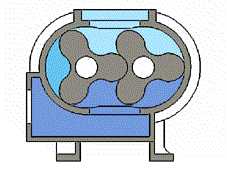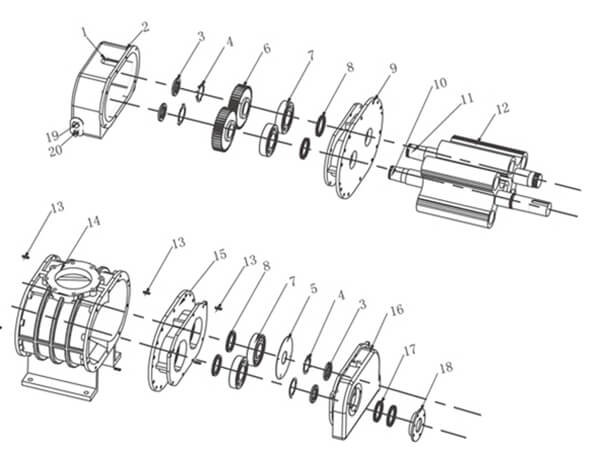At the time of global energy shortage, Roots blower, like other blowers, has the problem of improving efficiency and reducing power consumption. Today let’s have a look at the Roots Blower selection and applications in different industries.

1. Principle of Roots Blower Model Selection
Firstly, we should select the model, structure, and material of the roots blower according to the performance parameters, purpose, process requirements, and application occasions to meet the required working conditions. The inlet flow and pressure rise of the roots blower shall be close to the process requirements as much as possible, so as to make the roots blower operate efficiently. Otherwise, it will cause accidents and waste of energy.
To select the model of three lobes roots blower according to the nature of the conveyed medium, the flow, and pressure required by the process flow. At the same time, we should consider the pressure loss from pipe network resistance and the flow loss.

The required airflow and pressure rise shall preferably be actually measured at the rated load of the system. If it is a new project, it can be obtained by theoretical calculation. We can also learn from the actual operation values of similar systems and make analogical calculations to master the maximum and minimum values that the system may use, so as to facilitate the model selection.
The medium temperature shall be the highest temperature in normal operation. Before selection, we need to carry out actual measurements or investigate the previous operation records of the roots blower.
Finally, we should comprehensively consider the above data according to the operation of the existing blower, and finally determine the design parameters of the Roots Blower. So as to avoid the situation that the flow and pressure of the new roots blower can not meet the actual operational needs.
2. Roots Blower Development Trend
With the development of technology, the quality of domestic roots blowers has been continuously improved and has occupied most of the domestic market. Roots blower has the characteristics of small volume, lightweight, low noise, stable and reliable operation. In this case, roots blower is widely used in most industries. For example, powder transportation (cement, feed, small pieces), vacuum packaging, water treatment (aeration), aquaculture, electroplating tank mixing, combustion furnace, pneumatic transportation, and other industries.

Roots blowers mainly convey air. With different sealing structures, roots blower can also transport flammable, explosive, and corrosive gases such as biogas, hydrogen, acetylene, and carbon dioxide. It integrates blower, motor, filter, inlet, and outlet muffler, flexible joint, safety valve, check valve, and pressure gauge. It can be equipped with a PLC signal interface, intelligent monitor, and sound insulation cover.
3. Selection and applications of powder conveying industry
(1) Vertical kiln blower

Firstly, Raw cement is added from the top of the shaft kiln. Combustion supporting air is fed from the bottom or lower side of the kiln. The material falls vertically in the kiln by its own weight. The burned clinker is discharged from the lower part of the kiln, and the generated flue gas is discharged from the upper part of the kiln. Similar uses: small blast furnace and Cupola for ironmaking. Roots Blower Models:RSR200, RSR250, RSR300, MTRF250, MTRF300.
(2) Pneumatic ash conveying
coal-fired power plants can produce a large amount of fly ash in the production process. Firstly, the electrostatic precipitator is used to collect it into the ash hopper; Then put the coal ash into the transmission pipeline. Finally, use the compressed air discharged by the roots blower to make the coal ash flow into the ash silo; The following are the performance parameters for Roots blower.
Pressure rise: 68.6kpa; Airflow of 5 ~ 16m³/min.
Another common method is negative pressure suction at the end of the ash conveying system to make the fly ash fall into the ash silo. Roots Blower Models:RSR100, RSR125, RSR150.
(3) Polymer powder conveying
In the process of polymer production, we usually use nitrogen to transport granular raw materials such as polyethylene and polypropylene. The purpose of using nitrogen is to prevent the explosion of polymer raw materials with air and flammable and volatile media. In order to reuse nitrogen, the conveying system is a closed-loop. After filtration, The delivered gas will return to the blower for recycling. Roots Blower Models:RSR100, RSR125, RSR150, RSR200, MTRR150, MTRR190.
4. Roots Blower Selection and applications of vacuum packaging industry
Food vacuum packaging
Place food in flexible bags. There is An air extraction port at the opening of the bag. Draw out the air in the bag with negative pressure, and then seal the bag mouth with a heat sealer. Because most of the air in the bag is eliminated and the moisture in the bag is controlled, it can be used for food moisture-proof, mildew proof, oxidation proof, etc. Common models: RSR80, RSR100, RSR125, RSR150.
5. Roots Blower Selection and applications of wastewater treatment industry
Sewage aeration treatment:.

The blower is mainly used to provide sufficient dissolved oxygen for aerobic bacteria in the water body and provide power for stirring the mixed liquid in the aeration tank. It is commonly used for aeration treatment of industrial wastewater and urban domestic sewage such as papermaking, textile, printing and dyeing, electroplating, viscose fiber, petrochemical industry, food processing, fermentation, and brewing. Therefore when selecting a roots blower, the air pressure depends on the water depth, pipe resistance, and water viscosity. The air capacity depends on the volume of water. Roots Blower Models:RSR50, RSR65, RSR80, RSR100, RSR125, RSR150, RSR200, RSR250, RSR300.
6. Selection and applications of Roots Blower in aquaculture industry
Aquaculture
Large-scale fish and shrimp farms use roots blowers to blow air into the aquaculture pond to increase the dissolved content of oxygen in the water. Because This can accelerate the oxidative decomposition of harmful substances, promote water purification and promote the growth of fish and shrimp. Similar devices are also used for oxygen supply and stirring in aquariums and live fish tanks. The air supply per minute for shrimp seedlings should reach more than 1.5% of the total water volume fraction. We can determine the pressure rise according to the following data. A. Water depth: B. Length and diameter of the transmission pipe, 3. Local loss of bubbles. Usually, the pressure rise is 19.6kpa at 1m water depth, 29.4kpa at 1-1.5m water depth, and 39.2kpa or higher above 1.5m. Roots Blower Models:RSR50, RSR65, RSR80, RSR100, RSR125.

7. Roots Blower Selection and applications in chemical industry
(1) Fluidized bed furnace air supply
In the gas-solid two-phase contact of chemical reaction, place the solid particles on the air distribution plate. Then the air from the roots blower will make the granular materials boil and fluidize, and fully contact with other reactants or catalysts, so as to improve the reaction speed and efficiency. For example, prepare phthalic anhydride from naphthalene, prepare sulfur dioxide from pyrite by roasting, etc. Similar uses: supply air for combustion furnace, etc. Roots Blower Models: RSR200, RSR250.
(2) Ozone generation source
There are dozens or even hundreds of groups of the same discharge tubes inside the tubular ozone generator. Each group of discharge tubes consists of two concentric tubes. The outer tube is a metal tube and the inner tube is a glass tube (the inner wall surface is silver or graphite conductive layer). The oxygen or air provided by the roots blower is the air source of the high concentration ozone generator. When passing through the discharge gap between the two tubes, the air convert to ozone. Roots Blower Models: RSR200H, RSR200.

Dozens or even hundreds of groups of the same discharge tubes are installed inside the tubular ozone generator. Each group of discharge tubes consists of two concentric tubes. The outer tube is a metal tube and the inner tube is a glass tube (the inner wall is coated with silver or graphite conductive layer). The oxygen or air provided by the roots blower is used as the air source of the high concentration ozone generator. Therefore When passing through the discharge gap between the two tubes, part of it is converted to ozone. Roots Blower Models: RSR200H, RSR200.
(3) Air humidifying device
Firstly, water is supplied to the center of the splash tray. Under the action of centrifugal force, water flies around. The air discharged by the roots blower atomizes the water droplets and blows the water mist to every corner of the room. It can adjust The humidity of the air by changing the spray volume properly. Textile workshop mixing, cigarette, and printing factory anti-static usually use this system. Commonly used Roots Blower models: RSR100, RSR125.
(4) Paper paddle dewatering
A filter screen is laid on the surface of the hub, and a plurality of radially arranged cavities are arranged inside. During operation, the mesh surface adheres to the pulp, and the cavity will successively connect with the vacuum pump extraction area and the blower pressure area through the distribution valve. When passing through the air extraction area, it will separate the waste liquid from the pulp. After arrives the pressure area, it will loosen outward the pulp layer and finally scrap down by the scraper. Common used Roots Blower models: RSR150, RSR200H, RSR200, RSR250D.
(5) Electroplating solution stirring
Use the compressed air provided by the blower to stir the electroplating solution. Therefore, it can obtain a high-quality current density. The temperature of the solution everywhere can be uniform. The solution around the workpiece can be continuously updated by stirring. So that it will realize the rapid transmission of ions and the uniform deposition of non-metallic particles. At the same time, it can wash away the dirt and grease from the workpiece, so as to improve the electroplating quality.
8. Roots Blower Selection and applications in other industries
(1)Pressure conveying industry
Three lobes roots blower can be used for pressure conveying flour in flour mill because of its pressure self adaptability. When the flour is fed into the granary, the pressure disappears. We should choose the pressure according to the following factors: A. Pipe length; B. Resistance: C. Conveying material ratio. Generally, pressure rise is 49.0-78.4kpa and air Flow is 2-45m³/ min. Similar use: pipeline cleaning, etc.
(2)City gas transmission
With the development of urban construction, gas pipelines have gradually entered thousands of households. A three-blade roots blower can be used on various occasions because of its high pressure and good sealing. The performance parameters of general gas conveying roots blowers are pressure 68.6kpa, flow 40, 60, 80m/min, optional models: RSR200H, RSR200, RSR250.

9. Conclusion
Combined with the current situation of three lobes roots blower at home and abroad, this paper introduces the selection principle of Roots blower and gives the selection and application classification under the actual operating environment of various industries. It has important reference value for users and design institutes to select the most ideal models of three-blade roots blower. Shandong Mingtian Machinery Group is manufacturing roots blowers and vacuum pumps since 2007. If you have any questions about roots blower selection and applications, feel free to contact us.
